1) 鐔 竹虎図
Design: Tiger with a bamboo leaves, animal zodiac of 2010 |
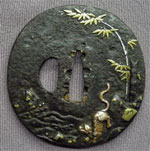 |
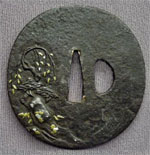 |
1) 鐔 竹虎図
寸法: 縦79.5×横77.0×厚さ4.0 (mm)
解説:鉄地に金・銀象嵌などで虎や竹が描かれバランス良く仕上がっている。
両者は力強い様から好画題として描かれ、また虎は竹林に住むこと
からもその関係性は深い。江戸時代中期。(18世紀)
Design: Tiger with a bamboo leaves, animal zodiac of 2010
A ferocious looking tiger and a strong looking bamboo are loved by Samurai
and they are described together as a good subject. A tiger, a bamboo leaves
with gold and silver inlay on the iron ground.18th century.
|
2) 鐔 正月飾り図
Design: Scene of New Year cerebration.
sold |
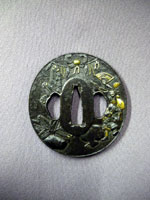 |
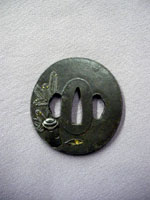 |
2) 鐔 竹虎図
寸法: 縦79.5×横77.0×厚さ4.0 (mm)
解説:鉄地に金・銀象嵌などで虎や竹が描かれバランス良く仕上がっている。
両者は力強い様から好画題として描かれ、また虎は竹林に住むこと
からもその関係性は深い。江戸時代中期。(18世紀)
Design: Tiger with a bamboo leaves, animal zodiac of 2010
A ferocious looking tiger and a strong looking bamboo are loved by Samurai
and they are described together as a good subject. A tiger, a bamboo leaves
with gold and silver inlay on the iron ground.18th century.
鐔 正月飾り図
寸法:縦75.0×横71.0×厚さ4.2 (mm)
解説:正月の注連飾りや、歌い踊りその年の繁栄を祝う万才師二人などが面白く描かれている
大変お目出度い正月風景の図柄。
Design: Scene of New Year cerebration.
|
3) 鐔 月兎木賊図
Design: Hare with scouring rush under a moon
sold |
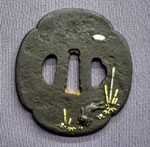 |
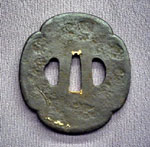 |
3) 鐔 月兎木賊図
寸法:83.0×横76.5×厚さ4.5 (mm)
解説:鉄地木瓜形に雲の上から顔を出し、照らす月の下で飛跳ねる兎と
木賊(とくさ)が配してある。古来より、月には兎が住んでいる等のいろいろな物語よって
兎と月は結びつけられ、広く親しまれている。
うさぎの反動をとりながら前へ跳躍するその様が、「躍進」の意味があるとされ
縁起物として武士等に大変好まれた。江戸時代後期(19世紀)。
Design: Hare with scouring rush under a moon
There is a deep relationship between hare and moon because it has been
believed that hare lives in moon since old times.
Hare is esteemed as an auspicious motif, and have a meaning of progress
because hare is able to jump strongly and overcome one’s hardship. 19th century. |
4) 鐔 竹林に虎図
Design: Tiger with a bamboo leaves, animal zodiac of 2010 |
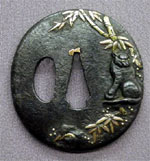 |
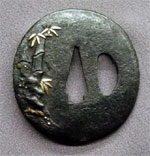 |
4) 鐔 竹林に虎図
寸法: 縦68.5×横64.0×厚さ4.5 (mm)
解説: 2010年の干支である虎はその猛々しい様子から、竹は常緑であり
屈することなく真直ぐ伸びる力強い様子から、この組み合わせは特
に武士に好まれた画題。可愛らしい動きに愛嬌がある。
江戸時代後期。(19世紀)
Design: Tiger with a bamboo leaves, animal zodiac of 2010
A strong-looking bamboo leaves with copper and brass inlay were described
on the iron ground. And we can enjoy seeing the attractive-looking tiger.
19th century.
|
5) 目貫 猛虎図 無銘 横谷
Design: Tiger by Yokoya School, animal zodiac of 2010 |
 |
5) 目貫 猛虎図 無銘 横谷
寸法:左) 縦13.5×横38.0(mm) 右) 縦12.0×横38.0(mm)
解説:豪華な金無垢地に毛並みが細かく見事に猛虎を表現した横谷派の逸品。
幕府彫物御用の後藤家を「家彫」と称するのに対し、その他の金工を「町彫」と呼ぶ。
横谷派は宗与を初代とした町彫の一大流派で柳川派、奈良派、大森派などの各流派に大きな影響を与えた。
江戸時代後期。(19世紀) 保存鑑定書付。
Design: Tiger by Yokoya School, animal zodiac of 2010
This elegant Menuki is made of solid gold and made by Yokoya School
who is known as a main school of “Machibori” (works for merchant culture.).
They have a great influence on many schools, Yanagawa, Nara, Omori etc.
19th century. Hozon certificate paper.
|
7) 目貫 親子虎図 無銘 横谷派
Design: Parent and children of tiger, animal zodiac of 2010 |
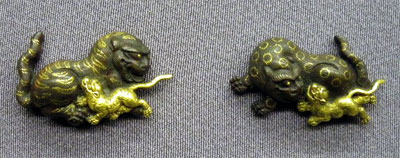 |
7) 目貫 親子虎図 無銘 横谷派
寸法:左) 縦12.5×横29.0(mm) 右) 縦12.0×横29.0(mm)
解説:古くは縦縞柄(虎)を雄・斑柄(豹)が雌と思われ夫婦であるとされていた。
獰猛と思われている虎は、家族を大事にすることでも知られる。
横谷派の作と思われる本作は子供と戯れる親子虎の様子が見て取れ面白い。
江戸時代後期。(19世紀)
Design: Parent and children of tiger, animal zodiac of 2010
People in those days were considering striped tiger as a male and spotted
tiger as a female. A tiger is known that takes a good care of own family
though
they are fierce. Parent and children which get along well were described.
This is attributed to Yokoya School. 19th century.
|
8) 目貫 一疋虎図 無銘 古後藤
Design: Tiger by Ko-Goto in 16th century, animal zodiac of 2010 |
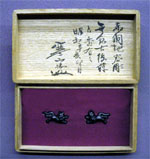 |
 |
8) 目貫 一疋虎図 無銘 古後藤
寸法:左) 縦15.0×横31.0(mm) 右) 縦15.5×横30.0(mm)
解説:古後藤の作と思われ時代の古さが窺える。本作は落ち着きのある赤銅地を容彫にし
た優品。佐藤寒山箱書付。室町時代後期。(16世紀)
Design: Tiger by Ko-Goto in 16th century, animal zodiac of 2010
This Shakudo Menuki was made by Ko(old)-Goto School who is famous
as a head family in metalworker,
and employed by Shogun from Muromachi (15c.) to Edo period (19c.).
The description on the box is written
by Dr. Sato Kanzan who is active in 20th century as a sword authority.
|